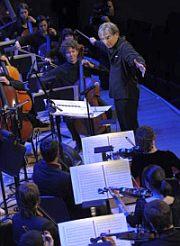
Symphony Orchestra
The gestation was short. The YouTube Symphony Orchestra project was launched in a New York-London media blitz just four months ago. Since then some 3,000 musicians from 70 countries participated in online auditions, uploading their performances of prescribed repertoire, including the orchestral part for their instrument of Internet Symphony No. 1, “Eroica,” composed by the Chinese-American composer Tan Dun for the occasion. As Tilson Thomas quipped, the experience supplied a new response to the old saw, “How does one get to Carnegie Hall?” Answer: “Upload, upload, upload!” It worked for the lucky ones, who were brought to New York for rehearsals and the concert.
It was probably best to sit back and enjoy the event, unhindered by questions about where the YouTube Symphony will goes from here or the project’s underlying rationale. Tilson Thomas touched on the future by saying that he didn’t know what “the many different teams” were up to, which presumably means that the orchestra does have a future but it hasn’t yet been determined.
From Upload to Uplift
The concert should work in favor of more to come. Tilson Thomas had the orchestra sounding in really good shape, though it was heard in morsels, not, say, in the entire Mahler Seventh. First came a vigorous performance of the fourth movement of Brahms’ Symphony No. 4 in E Minor, which sounded generally good despite a hint of muddiness and a few raucous brass sounds. And the final work was the fourth movement of another fourth symphony — Tchaikovsky’s, heard in a bracing performance. A bristling account of the "Ride of the Valkyries" from Wagner’s Die Walküre closed the first half.

Of two works that blended oriental and American elements, Lou Harrison’s Music From Canticle No. 3 outclassed Tan Dun’s Internet Symphony, which lasted only four minutes but made a mighty noise.
Some pieces showcased individual orchestral sections. The brass, deployed antiphonally in boxes on opposite sides of the hall for Gabrieli’s sumptuous Canzon septimi toni No. 2, edged out the more mellow sounding woodwinds, as heard in music from Dvořák’s Serenade in D Minor. Strings made an especially strong impression in Debussy’s “Nuages” (Clouds) from his Nocturnes.
There were some fine soloists too. Pianist Yuja Wang offered dazzlingly fleet playing in the Scherzo from Prokofiev’s Second Piano Concerto, and soprano Measha Brueggergosman sang the amusing, collagelike vocal part of John Cage’s Aria With Renga. Especially charming were three 8-year-olds — Derek Wang, Charlie Liu, and Anna Larsen — playing a waltz by Rachmaninov at one piano.
Projections accompanied most of the pieces, the most interesting of which was “Women in Art,” a fascinating sequence of famous portraits of women, by artists from Leonardo Da Vinci to Pablo Picasso, each one morphing into the next. It took one’s attention away from Joshua Roman’s playing in Bach’s Sarabande from the Suite No. 1 in G Major for solo cello. In furtherance of the collegial tone, taped mini-biographies of several players were interleaved through the program — a cellist who described himself as a professional poker player, an African-American music teacher who played the violin, an Italian pianist who said he was still deciding what to do when he grew up.
And the Payoff?
Despite the high spirits, it was hard to keep from wondering what the point of the YouTube Symphony really is. Does Google (which owns YouTube) really think it is doing something positive for classical music? Or is it just trying to polish the image it cultivates for doing good? Or maybe it wants to drum up advertising for YouTube. The project’s budget was not disclosed, but it must have cost a fortune, since everything was done on a royal scale and the top ticket price was only $25.
By chance the concert occurred on the same day an article appeared in The New York Times about an 18-year-old violinist, concertmaster of her school orchestra, which is coming to New York for an event. But she is too financially strapped to consider a career in music, and her school district too financially strapped to ensure the orchestra’s survival. That story put the YouTube Symphony in perspective.
What YouTube does next will be awaited with interest. But let’s hope it involves something meaningful for classical music in America and the rest of the world.

